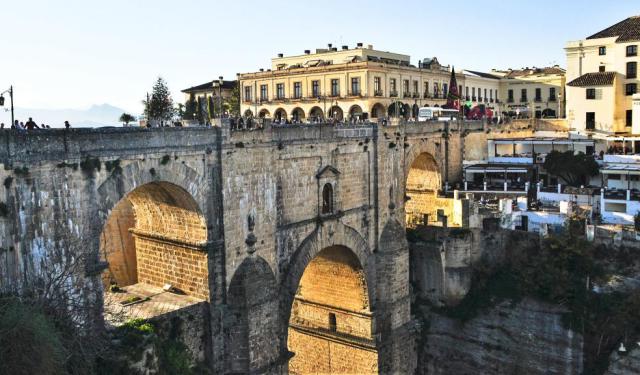
Puente Nuevo (New Bridge), Ronda (must see)
The New Bridge (Puente Nuevo) could be called Second Bridge (Puente Segundo), as it is the second span over the river gorge at that spot. The first attempt was the work of architects Jose Garcia and Juan Camacho in 1735. The bridge had a single-arch design. It was put together rather quickly and not well. It collapsed in 1741, killing 50 people.
The New Bridge of today is the largest and newest of the three bridges spanning the chasm of the River Guadalevin. It was completed in 1793 by Andalucian architect Jose Martin de Aldehuela, replacing the earlier attempt of Garcia and Camacho. The high central arch is flanked by two smaller, shorter arches.
The chamber above the central arch has seen several uses, including that of a prison and torture chamber. It was used as such by both sides in the civil war of 1936-1939. More than a few prisoners are said to have met death on the rocks of Ronda Gorge (El Tajo de Ronda). The chamber guardhouse today has exhibits on the history and construction of the bridge.
The project of spanning Ronda Gorge was first suggested by King Philip V in 1735. The intention was to supplement the 16th-century bridge, now called the Old Bridge (Puente Viejo), and the 12th-century Moorish bridge next to the Arab Baths. The New Bridge spans Ronda Gorge at its highest point. There are sidewalks and seating on each side of the bridge.
The New Bridge connects the parts of the city, Little Market (El Mercadillo) and the Old City (La Ciudad). The bridge chamber is open to visitors Monday through Friday from 10 am to 6 pm. On Saturdays, hours are 10 am to 1:45 pm and 3 pm to 6 pm. Sunday times are 10 am to 3 pm. There is a modest admission fee.
The New Bridge of today is the largest and newest of the three bridges spanning the chasm of the River Guadalevin. It was completed in 1793 by Andalucian architect Jose Martin de Aldehuela, replacing the earlier attempt of Garcia and Camacho. The high central arch is flanked by two smaller, shorter arches.
The chamber above the central arch has seen several uses, including that of a prison and torture chamber. It was used as such by both sides in the civil war of 1936-1939. More than a few prisoners are said to have met death on the rocks of Ronda Gorge (El Tajo de Ronda). The chamber guardhouse today has exhibits on the history and construction of the bridge.
The project of spanning Ronda Gorge was first suggested by King Philip V in 1735. The intention was to supplement the 16th-century bridge, now called the Old Bridge (Puente Viejo), and the 12th-century Moorish bridge next to the Arab Baths. The New Bridge spans Ronda Gorge at its highest point. There are sidewalks and seating on each side of the bridge.
The New Bridge connects the parts of the city, Little Market (El Mercadillo) and the Old City (La Ciudad). The bridge chamber is open to visitors Monday through Friday from 10 am to 6 pm. On Saturdays, hours are 10 am to 1:45 pm and 3 pm to 6 pm. Sunday times are 10 am to 3 pm. There is a modest admission fee.
Want to visit this sight? Check out these Self-Guided Walking Tours in Ronda. Alternatively, you can download the mobile app "GPSmyCity: Walks in 1K+ Cities" from Apple App Store or Google Play Store. The app turns your mobile device to a personal tour guide and it works offline, so no data plan is needed when traveling abroad.
Puente Nuevo (New Bridge) on Map
Sight Name: Puente Nuevo (New Bridge)
Sight Location: Ronda, Spain (See walking tours in Ronda)
Sight Type: Attraction/Landmark
Guide(s) Containing This Sight:
Sight Location: Ronda, Spain (See walking tours in Ronda)
Sight Type: Attraction/Landmark
Guide(s) Containing This Sight:
Walking Tours in Ronda, Spain
Create Your Own Walk in Ronda
Creating your own self-guided walk in Ronda is easy and fun. Choose the city attractions that you want to see and a walk route map will be created just for you. You can even set your hotel as the start point of the walk.
Ronda Introduction Walking Tour
Ancient rock paintings found in the area tell us Ronda was settled by Celts, who called it "Arunda." Phoenicians and Romans followed the Celts. Muslim rule was established in 713 by the Umayyads, who called it the "Castle of Rundah." Islamic domination ended in 1485 when Rodrigo, Duke of Cadiz, conquered the city.
Seen from the air, Ronda is breathtaking. It is in two parts,... view more
Tour Duration: 2 Hour(s)
Travel Distance: 2.8 Km or 1.7 Miles
Seen from the air, Ronda is breathtaking. It is in two parts,... view more
Tour Duration: 2 Hour(s)
Travel Distance: 2.8 Km or 1.7 Miles

